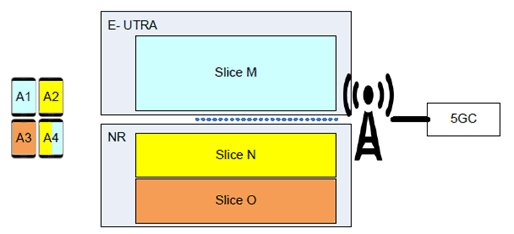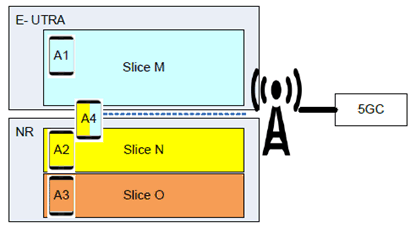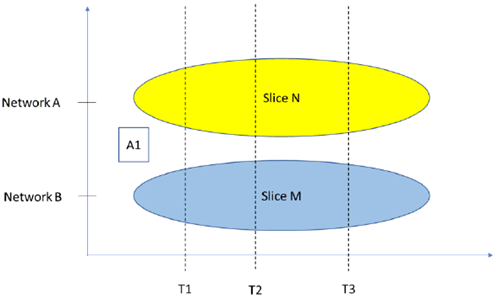Content for TR 22.835 Word version: 18.2.0
5.4 Use of Multi-RATs for network slices
5.4.1 Description
5.4.2 Pre-conditions
5.4.3 Service Flows
5.4.4 Post-conditions
5.4.5 Existing features partly or fully covering the use case functionality
5.4.6 Potential New Requirements needed to support the use case
5.5 Use case on access to slices when roaming
5.5.1 Description
5.5.2 Pre-conditions
5.5.3 Service Flows
5.5.4 Post-conditions
5.5.5 Existing features partly or fully covering the use case functionality
5.5.6 Potential New Requirements needed to support the use case
5.6 Use case on simultaneous access to multiple slices on different VPLMNs
5.6.1 Description
5.6.2 Pre-conditions
5.6.3 Service Flows
5.6.4 Post-conditions
5.6.5 Existing features partly or fully covering the use case functionality
5.6.6 Potential New Requirements needed to support the use case
...
...
5.4 Use of Multi-RATs for network slices p. 16
5.4.1 Description p. 16
5GC is connected to NG-RAN and the NG-RAN supports both E-UTRA and NR. However, for a third party who wants to utilize a network slice, the different potential and flexibility of E-UTRA and NR is not something that can easily be disregarded.
Also, the unequal possibility of radio resource slicing for NR and E-UTRA leads to a unique use case scenario.
5.4.2 Pre-conditions p. 16
Figure 5.4.2-1 shows the use case scenario where an NG-RAN is supporting both NR and E-UTRA radio resources.

In this Figure, it is assumed that
-
Subscription:
- UE A1 and A4 are subscribed to a service using Slice M.
- UE A2 and A4 are subscribed to a service using Slice N.
- UE A3 is subscribed to a service using Slice O.
-
Deployment:
- E-UTRA is configured to serve Slice M, e.g. for general eMBB services, including a slice for IMS service.
- NR is configured to serve Slice N and O, e.g. for URLLC or V2X. Due to demanding requirements of V2X application, V2X application providers (e.g. OEM) requests to use only NR for Slice O.
5.4.3 Service Flows p. 16
The following is an example service flow based on the setting in the previous section:
- After power-on, UE A1, A2, A3 and A4 start searching for cells.
- UE A1, A2, A3 and A4 start registration in the found cells.
- Depending on factors such as e.g., use of Dual Connectivity, priorities of network slices, different UEs may camp on different RATs. For example, the UE A1 may camp on E-UTRA.
- Based on the various inputs, for the transport of user traffic for a network slice, the RAT and radio resources can be configured. For example, when user traffic for slice M is generated for UE A4, the network may configure E-UTRAs resource for the UE to deliver the traffic. For this UE A4, when user traffic for slice N is generated, the network may configure NR resources for the UE. When both NR and E-UTRA resource are configured, the user traffic for the network slice only flows over the allowed RATs.
- When service policy changes, e.g. when slice M is now set to use NR instead of E-UTRA, UEs camp NR cells instead of E-UTRA cells. For a UE with ongoing active communication, handover occurs to move the UE from E-UTRA to NR.
5.4.4 Post-conditions p. 17
The following Figure 5.4.4-1 shows the status at the end of the service flow. For the transport of user traffic, UE A1 is served by E-UTRA, UE A2 and A3 are served by NR. UE A4 may camp on either E-UTRA or NR during Idle mode and be configured with E-UTRA, NR or both depending on the active application during Connected mode.

5.4.5 Existing features partly or fully covering the use case functionality p. 17
TS 22.261 contains many requirements related to user traffic management and network slices.
- The 5G system shall allow the operator to define and update the set of services and capabilities supported in a network slice.
- Based on operator policy, a 5G network shall provide suitable APIs to allow a trusted third-party to create, modify, and delete network slices used for the third-party.
- Based on operator policy, the 5G network shall provide suitable APIs to allow a trusted third-party to define and update the set of services and capabilities supported in a network slice used for the third-party
5.4.6 Potential New Requirements needed to support the use case p. 17
The following new requirements can be derived from this use case:
[PR.5.4.6-1]
5G system shall minimize signaling exchange and service interruption when there is a change in the allowed radio resources (e.g. RATs) for a network slice.
5.5 Use case on access to slices when roaming p. 17
5.5.1 Description p. 17
A UE subscribes to multiple network slices from its home operator. The home operator has agreements with various other operators to support the same slices for roaming UEs. In this case, the most preferred VPLMN in a specific area does not support all the needed slice; however, a second VPLMN does support the slice not available in the most preferred VPLMN. In this case, the home operator can provide the necessary information to allow the UE to use the second VPLMN to obtain the service available on that network slice, while otherwise being served by the most preferred VPLMN. Figure 5.5.1-1 illustrates the scenario.

Figure 5.5.1-1: Roaming UE with subscriptions to services on network slices available on different networks
(⇒ copy of original 3GPP image)
(⇒ copy of original 3GPP image)
5.5.2 Pre-conditions p. 18
In this scenario, the UE A1 is roaming in an area covered by 2 VPLMNs, Network A and Network B. UE A1 subscribes to services that require use of slices M and N in its home network. The corresponding slices and services are available in the visited area, even though these slices are not offered by the same network in the visited area. Network A is the most preferred VPLMN in this area.
5.5.3 Service Flows p. 18
When UE A1 first enters the visited area, it registers with Network A and can uses services from slice N.
At a later time (T2), the user decides to activate a service that needs slice M. The UE, detecting that slice M is not available on Network A, looks for the network that provides the slice. The UE registers on Network B and the user is able to use the service of slice M.
When the service concludes and slice M is no longer needed (T3), the UE returns to Network A.
5.5.4 Post-conditions p. 18
The user is able to access all their subscribed services while roaming, even though the needed slices are not available on a single VPLMN.
5.5.5 Existing features partly or fully covering the use case functionality p. 18
Roaming and slice access work as usual, with the addition of being able to change VPLMNs to gain access to a slice not available on the most preferred VPLMN.
5.5.6 Potential New Requirements needed to support the use case p. 18
[PR.5.5.6-1]
For a roaming UE activating a service/application requiring a network slice not offered by the serving network but available in the area from other network(s), the HPLMN shall be able to provide the UE with prioritization information of the VPLMNs with which the UE may register for the network slice.
5.6 Use case on simultaneous access to multiple slices on different VPLMNs p. 18
5.6.1 Description p. 18
A UE has access to multiple network slices when on the HPLMN. When the UE is roaming and the VPLMN where the UE is currently registered only provides a subset of the network slices that the UE needs to use, the UE can connect to other VPLMNs at the same time to access the other subscribed network slices.
5.6.2 Pre-conditions p. 19
- UE is subscriber of Operator Toffee
- When on its home network, Operator Toffee, UE has access to three network slices: (A)pricot, (B)anana and (C)herry
- UE runs different applications that require the UE to simultaneously access Apricot, Banana and Cherry slices
-
Operator Toffee has agreements with:
- Operator Chocolate to support Apricot and Banana slices
- Operator Fudge to support Cherry slice
- Operator Chocolate is the preferred roaming network
- UE moves out of Operator Toffee's coverage area, into an area where the coverage is provided by Operator Chocolate and Operator Fudge
5.6.3 Service Flows p. 19
- UE connects with Operator Chocolate, and has access to Apricot and Banana slices
- UE requires simultaneous access to all three slices, Apricot, Banana and Cherry, due to the different applications running on the UE. However, the VPLMN the UE is registered to, Operator Chocolate, does not provide support for Cherry slice
- UE is authorised by the HPLMN to additionally access the Cherry slice in the Operator Fudge network.
- UE connects to Operator Fudge's network, while retaining the connection to Operator Chocolate
5.6.4 Post-conditions p. 19
Roaming UE is able to access all three network slices simultaneously from Operator Chocolate and Operator Fudge.
5.6.5 Existing features partly or fully covering the use case functionality p. 19
There are related requirements in clause 6.18 of TS 22.261 on "Multi-network connectivity and service delivery across operators":
The 5G system shall enable users to obtain services from more than one network simultaneously on an on-demand basis.
For a user with a single operator subscription, the use of multiple serving networks operated by different operators shall be under the control of the home operator.
Clause 5.3.2.4 of TS 23.501 on "Support of a UE registered over both 3GPP and Non-3GPP access" indicates:
A UE supporting registration over both 3GPP and Non-3GPP access to two PLMNs shall be able to handle two separate registrations, including two 5G-GUTIs, one per PLMN, and two associated equivalent PLMN lists.
Also, clause 6.3.2 of TS 33.501 on "Multiple registrations in same or different serving networks".
5.6.6 Potential New Requirements needed to support the use case p. 19
[PR.5.6.6-1]
For UEs that have the ability to obtain service from more than one VPLMN simultaneously, the following requirements apply:
-
When a roaming UE with a single PLMN subscription requires simultaneous access to multiple network slices and the network slices are not available in a single VPLMN, the 5G system shall enable the UE to:
- be registered to more than one VPLMN simultaneously; and
- use network slices from more than one VPLMN simultaneously
- The HPLMN shall be able to authorise a roaming UE with a single PLMN subscription to be registered to more than one VPLMN simultaneously in order to access network slices of those VPLMNs.
- The HPLMN shall be able to provide a UE with permission and prioritisation information of the VPLMNs the UE is authorised to register to in order to use specific network slices.